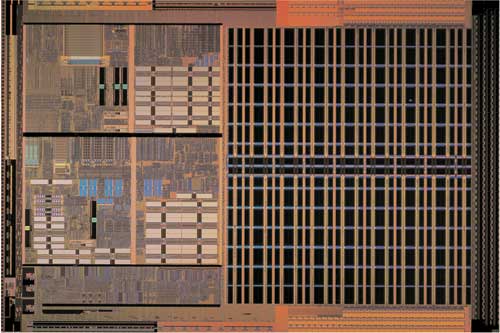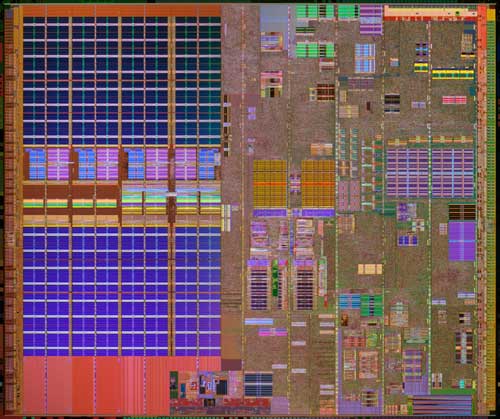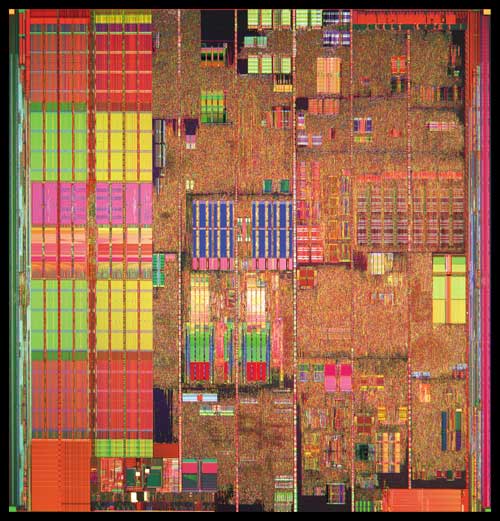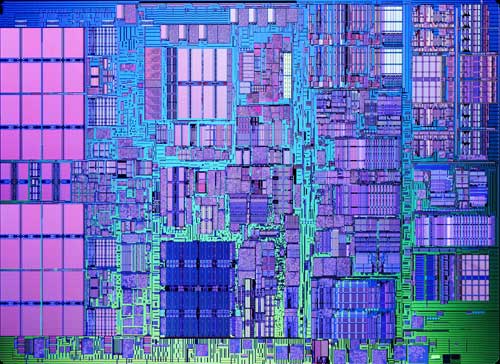Intel Pentium 4 6xx and 3.73EE: Favoring Features Over Performance
by Anand Lal Shimpi & Derek Wilson on February 21, 2005 6:15 AM EST- Posted in
- CPUs
An Interesting Observation: Prescott 2M's Die
What has been true for a number of modern day microprocessors is that the vast majority of the CPU is made up of cache, take a look at the Athlon 64 FX with its 1MB L2 cache:

AMD Athlon 64 FX die (the large block to the right is its 1MB L2 cache)
Over half of the die is L2 cache.
But when looking at the new Prescott 2M core the same can't be said:

Intel Pentium 4 600 series die (the large block to the left is its 2MB L2 cache)
The split between logic and cache is almost 50/50, looking back at the original Prescott we see that the Prescott core itself actually occupied more die area than the cache:

Intel Pentium 4 500 series (the block to the left is its 1MB L2 cache)
There are two explanations for the phenomenon, first with Prescott Intel introduced their highest density cache ever produced; at present day it holds the record for largest cache with the smallest area on a modern desktop microprocessor. Secondly, is the fact that Prescott, with its 31 pipeline stages, 64-bit execution units and highly accurate branch predictors with massive branch history tables, is simply a big, complex core. Also remember that the Athlon 64 is basically a reworked K7 core, with wider execution units and datapaths, as well as an on-die memory controller, so it is understandably simpler.
Let's compare that to the Pentium M:

Intel Pentium M 90nm (the large block is its 2MB L2 cache)
The PowerPC 970 (used in Apple's G5 systems) looks a bit more Prescott like, but remember we're only dealing with a 512KB L2 cache here:

IBM PowerPC 970 (the block to the left is its 512KB L2 cache)
Or, even more interestingly, compare it to the newly announced Cell processor:

IBM/Sony/Toshiba Cell microprocessor (we apologize for the quality of the die shot, it's the best we could find)
Looking at Cell is quite interesting because it appears to be just as complex as Prescott, but remember that with Cell we're looking at 9 individual processors. But more on that next week...
Extreme Edition - Not so "Extreme" Anymore
Back when the Extreme Edition was first launched, the Pentium 4 had a "meager" 512KB L2 cache compared to the EE's 2MB L3 and 512KB L2. Now that the Pentium 4 has a 2MB L2 cache and is based off of the same core as the EE, the only benefit that the Extreme Edition offers is 1066MHz FSB support and a slightly higher clock speed.
We looked at the impact of the 1066MHz FSB in the past and quickly found that it didn't do much for the EE. Although we're now running at 3.73GHz for the Pentium 4 Extreme Edition, the benefit from the 1066MHz FSB is still pretty limited.
As for the clock speed advantage, the fastest Pentium 4 6xx is the 660, running at 3.60GHz - 96.4% of the clock speed of the 3.73GHz Extreme Edition - the clock speed difference is effectively nothing.
But the price? The 3.73 EE will retail for $999, the Pentium 4 660: $605. The Extreme Edition was never a good value, but in the case of the new chip, it's basically throwing money away. Let the benchmarks speak for themselves, but your best bet is to wait for the next generation of Extreme Edition CPUs, either with a 4MB L2 cache or the dual core offerings.










71 Comments
View All Comments
Alfaneo - Friday, August 26, 2005 - link
here is 478 pin result
Run All Summary
---------- SUM_RESULTS\3DSMAX\SUMMARY.TXT
3dsmax-03 Weighted Geometric Mean = 16.99
---------- SUM_RESULTS\CATIA\SUMMARY.TXT
catia-01 Weighted Geometric Mean = 14.27
---------- SUM_RESULTS\ENSIGHT\SUMMARY.TXT
ensight-01 Weighted Geometric Mean = 20.60
---------- SUM_RESULTS\LIGHT\SUMMARY.TXT
light-07 Weighted Geometric Mean = 12.34
---------- SUM_RESULTS\MAYA\SUMMARY.TXT
maya-01 Weighted Geometric Mean = 18.69
---------- SUM_RESULTS\PROE\SUMMARY.TXT
proe-03 Weighted Geometric Mean = 16.74
---------- SUM_RESULTS\SW\SUMMARY.TXT
sw-01 Weighted Geometric Mean = 14.16
---------- SUM_RESULTS\UGS\SUMMARY.TXT
ugs-04 Weighted Geometric Mean = 18.35
blckgrffn - Thursday, February 24, 2005 - link
Let's hope that they don't post it because they know that running 1T is imperative to get good performance number, and thus use it by default.Hans Maulwurf - Wednesday, February 23, 2005 - link
Many other sites don´t publish their command rate either, this looks very strange for me. Most sites used to publish them before. I don´t understand...L3p3rM355i4h - Wednesday, February 23, 2005 - link
I'm assuming 1T, although the ammount of pwnage that would occur if it was 2T would be incredible.Zebo - Wednesday, February 23, 2005 - link
Derek/Anand- Why is it you don't say what A64's command rate was? 1T or 2T? This makes a huge impact on A64's performance (as shown by Anand right here and myself in forums) and is sloppy jounalism to leave out. Sure "other" sites do this crap but not anandtech.:|Dualboy24 - Wednesday, February 23, 2005 - link
I am just not finding the releases to be impressive lately... I am waiting to see the future dual core etc... perhaps that will wow us all. Its just not like the 90s anymore where it was always an exciting time with CPUs.Perhaps a battle between 56kbps modem models would prove entertaining :) L()L
neogodless - Tuesday, February 22, 2005 - link
#64 I'm saying I don't bother. I don't do that at work (P42.4C) either. At work, I listen to MP3s while having 2 e-mail clients open, various browser windows and tabs, a development environment, FTP, database manager, various IM programs, remote desktop, etc. And I do about the same at home, though usually on a smaller scale. And it works fine. However, if I go to a web page that gobbles up resources (poorly written javascript, i can give you an example page), I'm able to do everything else on the HT machine which shows about "53%" overall CPU usage. An the Athlon 64, if something gobbles up CPU, I see "99%" usage and a sluggish environment. But it's ALL subjective... I want to see Objective measurements.I also don't want to see Athlon vs. Intel opinions/flames because I'm not claiming one or the other is better... just asking for objective measurements.
RZaakir - Tuesday, February 22, 2005 - link
neo, are you saying that you have problems running a game and listening to MP3s simultaneously on your Athlon 64?RockHydra11 - Tuesday, February 22, 2005 - link
Disappointing to say the least....neogodless - Tuesday, February 22, 2005 - link
I'm not sure why I got attacked for requesting Multi-tasking benchmarks. I prefer my AMD for gaming, and I prefer the Intel at work where I run lots of programs at once but (unfortunately) never game. It's not a fair comparison anyway because my home machine is limited by only one monitor, while my work machine has two.Yes, many benchmarks are optimized for Hyperthreading, and if they are synthetic, then it doesn't matter. I'm asking for benchmarks with programs you use every day. If they're optimized for Hyperthreading, then you will see real world benefit from that, when using an HT enabled processor.
When I run games on my AMD64, it gobbles up all the CPU (even if it's an old game) for whatever reason, and I don't find it practical to leave a game running in the background while doing something else. I've done it, and it didn't greatly hinder doing some small task like check e-mail or send an instant message, but I wouldn't intentionally do it, especially if I decided I'd rather listen to Mp3s than finish my game...